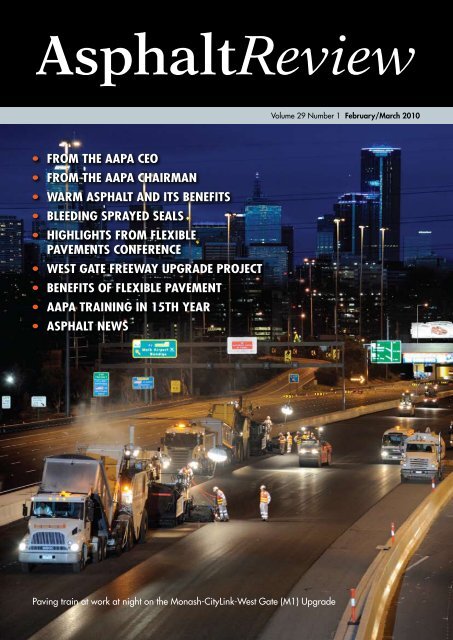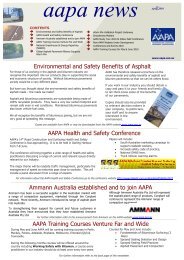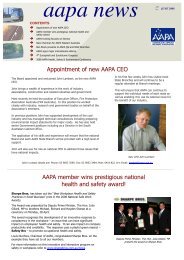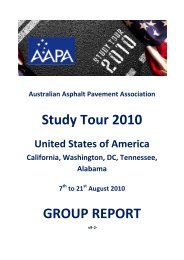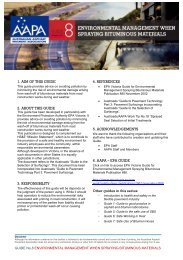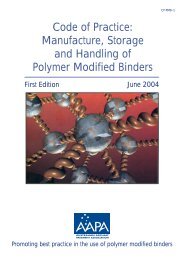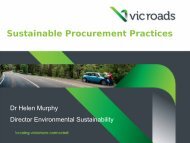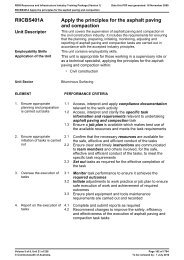Asphalt Review - Volume 29 Number 1 (February / March 2010)
Asphalt Review - Volume 29 Number 1 (February / March 2010)
Asphalt Review - Volume 29 Number 1 (February / March 2010)
- No tags were found...
You also want an ePaper? Increase the reach of your titles
YUMPU automatically turns print PDFs into web optimized ePapers that Google loves.
<strong>Asphalt</strong><strong>Review</strong><strong>Volume</strong> <strong>29</strong> <strong>Number</strong> 1 <strong>February</strong>/<strong>March</strong> <strong>2010</strong>• FROM THE AAPA CEO• FROM THE AAPA CHAIRMAN• WARM ASPHALT AND ITS BENEFITS• BLEEDING SPRAYED SEALS• HIGHLIGHTS FROM FLEXIBLEPAVEMENTS CONFERENCE• WEST GATE FREEWAY UPGRADE PROJECT• BENEFITS OF FLEXIBLE PAVEMENT• AAPA TRAINING IN 15TH YEAR• ASPHALT NEWSPaving train at work at night on the Monash-CityLink-West Gate (M1) Upgrade
ASPHALT REVIEWCEO’s reportIt seems just a few years ago that wewere all concerned about Y2K and thestart of the 21st century.Now we are in the year <strong>2010</strong>, ten yearson from the start of the new centuryand into a new decade. And what anamazing ride we have had over the lastten years.We can now manage our diaries andreceive emails on our mobile phones,there are hybrid cars, bio-fuels andplasma TVs. We have also survived theGlobal Financial CrisisDespite these changes our industryhas not had to make many majorchanges on the way we make ashphalt.In fact, asphalt roads are still beingmade in basically the same way asthey have for many years, although wehave continued to make improvementsto achieve better, longer lasting andhigher quality pavements. However,over the new decade our industry willface many challenges and opportunities.One of the challenges to be faced by allindustries will be that of greenhouse andsustainability.Those in our industry know thatasphalt pavements are already verylow greenhouse pavements. Comparedto other pavements such as concrete,asphalt has an extremely low greenhousefootprint. In fact, it has been determinedthat the total greenhouse emissionsassociated with a tonne of asphaltpavement are the same as that requiredto produce 25 litres of fresh orangejuice.<strong>Asphalt</strong> is also 100% recyclable andin the US, is the most recycled product.In the US over 80% of recycled asphaltpavement (RAP) is used in new pavements.This reduces the amount of energy usedto produce pavements and minimisesthe amount of material sent to land fill.Long life or perpetual pavements canalso last for very long, if not indefiniteperiods with just the top, wearing coursereplaced reducing maintenance costsand greenhouse emissions. Maintenanceof asphalt pavements is also able to becarried out quickly with little impacton traffic due to road closures. Smoothasphalt pavements also reduce trafficfuel consumption.Despite this, our industry mustcontinue to look for options to furtherJohn Lambert,CEO, AAPAreduce greenhouse emissions whilealso seeking to continually improvepavements.One way of reducing emissions is byusing warm mix asphalt (WMA). Thisreduces the amount of energy (andgreenhouse gas) associated with asphaltproduction as well as eliminatingvisible fuming and enhancing workerconditions.At a recent meeting of the GlobalStrategic Alliance of <strong>Asphalt</strong> PavementAssociations it was felt that in future,WMA would be the standard asphaltpavement across the world.Of course our industry cannot justchange to WMA without ensuring thatit will provide the same quality or betterthan conventional hot mix. Warm mixvalidation projects are therefore beingundertaken around the world includingin Australia. Projects in Australia arebeing conducted by AAPA in conjunctionwith industry and government membersto compare HMA to equivalent WMA.AAPA is also proposing to organisea study tour to the US in Augustwhich will include a focus on WMA,long life pavements and possibly thinsurfacing. This will be held followingthe International Society of <strong>Asphalt</strong>Pavements (ISAP) conference to be heldin Nagoya Japan. Details are still beingfinalised about the study tour but pleasecontact Cassandra Simpson from AAPAif you would like to register to receiveinformation. For information aboutthe ISAP conference refer to www.isapnagoya<strong>2010</strong>.jp.As we move into the second decadethere is still concern about the longterm impact of the global financialcrisis. Compared to other countries,particularly the UK and US, our industryin Australia has done reasonably well.And as the Australian economy seems tobe recovering relatively quickly we lookforward to continued growth. But tosustain growth in tight economic timesplaces challenges on all of us. This isa time that we should be particularlyvigilant to ensure that we providethe highest quality pavements at acompetitive cost. It is also a time wemust look to the future and ensure ourworkers are fully trained and can deliverthose high quality pavements.AAPA offers a wide range of relevantand practical training courses and thecalendar to these courses is containedin this edition of <strong>Asphalt</strong> <strong>Review</strong>. Ourassociated organisation, CPEE, alsooffers post graduate courses that willtrain the next generation of pavementengineers. For information about CPEErefer to http://www.pavementeducation.edu.au/page1.aspx.The next decade will have manychallenges and opportunities for ourindustry. We know that Australia musthave high quality roads to maintain ourhigh standard of living and our economy.We also know that road constructionand maintenance is an effective meansof quickly injecting money directly intoour community in a way that supportsliveability and commerce well into thefuture. Additionally we also know thatbituminous pavements are the bestpavements.We should therefore be tellingeveryone we meet about the benefitsof bituminous pavements. We have agreat story to tell and yet most peoplein the community, including politicians,don’t always understand the importanceof our work and the sustainable, safetyand economic benefits of bituminouspavements.For this reason, AAPA has prepared abrochure describing the sustainable andsafety benefits. This is available fromthe AAPA website (www.aapa.asn.au)for free download or hard copies maybe obtained from AAPA. Copies of thebrochure should be forwarded or givento as many people as possible. We havea good news story and we should spreadit widely.24 ROADS FEBRUARY <strong>2010</strong>/MARCH <strong>2010</strong>
ASPHALT REVIEWChairman’s reportThe last year has been a difficult onefor many people across Australia dueto the global economic crisis although,our industry – the flexible pavementindustry, has not been as severelyaffected as other industries.This is in part due to the governmentand community recognising theimportance of quality roads andrecognising that money injected intoroads has immediate and long lastingbenefits to our society and economy.But there may still be challengesahead as the government starts towind back the current budget deficit.Next year and beyond is therefore atime for our industry to maintain itsfocus on providing quality services atcompetitive costs. We must also remainfocused on occupational health andsafety and increasingly address issuesof sustainability.Throughout the next decade the Boardand the staff of AAPA will continueto support members to achieve theseobjectives. AAPA state branches andthe National Technology Committeewill continue to address a wide range ofcurrent and emerging issues. The AAPATraining Centre will also continue toprovide practical and relevant training.Louis Nucifora,Chairman, AAPADuring tough economic times someorganisations cut back on spending inareas such as training. They may also tryto save costs by cutting back on quality.However, during these times companiesshould remain focussed on the futureand continue to grow the competency ofstaff and ensure that quality standards arealways applied.Remember that by maintaining qualityand constantly looking at ways to improve,including in areas of sustainability, ourindustry will have a profitable and longlasting future.On behalf of the AAPA Board I wish allof you every success in the current yearand into to second decade of this century.<strong>Asphalt</strong> <strong>Review</strong> reports on theflexible pavements and bituminoussurfacing industry in Australiaand New Zealand. It is publishedby ROADS Magazine on behalfof Australian <strong>Asphalt</strong> PavementAssociation Limited (ABN 31 000770 123), a non-profit organisationformed to promote the economicuse of asphalt and other bituminousbound products based on soundtechnical and commercial groundsfor the benefit of its members, theircustomers and the community.Articles in <strong>Asphalt</strong> <strong>Review</strong>may be reprinted providedacknowledgement is given.Contributions of a news ortechnical nature on all aspects ofasphalt and bituminous surfacingare welcome.The <strong>Asphalt</strong> <strong>Review</strong> Magazine, prepared by the Australian <strong>Asphalt</strong>Pavement Association (AAPA) is now also produced as a supplementin the ROADS magazine. To gain access to a broader readership,AAPA has undertaken to publish within ROADS, but its content willmaintain the uniqueness and specialty focus on flexible pavementsthat <strong>Asphalt</strong> <strong>Review</strong> has provided for over 25 years. Availabilityof this and future issues of the <strong>Asphalt</strong> <strong>Review</strong> will continue via theAAPA web site: www.aapa.asn.au in addition to its inclusion inROADS magazine.The publishing schedule is: <strong>February</strong>-<strong>March</strong>; June-July; and October-November.ROADS AdvertisingTo reach the decision-makers in the roads field, you should consider advertising inRoads. For information on advertising rates, please contact Yuri Mamistvalov atHallmark Editions, Tel (03) 8534 5008 or email yuri@halledit.com.auADMINISTRATIONAAPA Head OfficeLevel 2, 5 Wellington StreetKew, Vic 3101Tel: (03) 9853 3595Fax: (03) 9853 3484Email: info@aapa.asn.auWebsite: www.aapa.asn.au<strong>Asphalt</strong> <strong>Review</strong>Editor: Rex PannellEmail: rex.pannell@halledit.com.auAdvertising: Yuri MamistvalovEmail yuri@halledit.com.auTel: (03) 8534 5008ROADS FEBRUARY <strong>2010</strong>/MARCH <strong>2010</strong> 25
ASPHALT REVIEWWarm <strong>Asphalt</strong> – and benefitsof using it in AustraliaThere has been a great deal of interest inWarm <strong>Asphalt</strong> (WMA) in Europe and theUS, and now this material is availablein Australia. Some parts of Europe andthe US have adopted WMA as a materialof choice, while a great deal of time andeffort is concentrated on comparing WMAto Hot Mix Ashpalt (HMA) at variouslocations. Australia and New Zealandalso have WMA sites in Sydney, Brisbane,Melbourne and Christchurch, all of whichare being monitored and show goodperformance to date.Warm asphalt is a generic termfor asphalt that is produced at lowertemperatures than HMA. Typically, HMAis produced at about 160 degrees Celsiusto ensure the bitumen and aggregate arecompletely mixed. WMA can be producedat temperatures ranging from 110 to 140degrees Celsius while maintaining fullbitumen coating of the aggregate, andability to be placed and compacted.There are many processes to makeWMA, but they come under two majorcategories – foaming or additives. Many ofthese processes are available in Australia.Using warm asphalt has numerousbenefits, including:Environmental BenefitsWMA presents a potential opportunity forsignificant savings in fuel consumptionat the asphalt production plant. Thesesavings from reduced heating of theasphalt ingredients result in reducedgreenhouse emissions which benefit allof our community. WMA literature claimsup to 30% reduction of greenhouse gasemissions when the material is at optimumtemperature.Occupational Health & SafetyBenefitsWMA provides safety benefits tomanufacturers since the materials andasphalt are at lower temperature comparedto HMA, and this creates a safer and morecomfortable workplace for people, withthe material easier to handle and devoidof fumes.Productivity GainsWMA answers the call for increasedproduction on projects that include deepasphalt layers – since the WMA is deliveredat lower temperature to HMA, the layercools in less time and the placement of thenext layer can commence earlier than ifHMA were used.Reduced Traffic DisruptionWMA surface layers can be returnedto normal traffic conditions faster thanHMA since the surface is cool and stable.This benefits the transport industry andcommuters by reducing the length oftime the road is under repair.Benefit for Remote AreasAdditionally, WMA can be the answerfor remote sites since WMA can beproduced at normal HMA temperaturesand then carted for extended time andplaced successfully. WMA provides theadvantage of compaction and placementat reduced temperatures – well belowthe temperature at which HMA wouldnot be workable.Even More Recycling CapabilityThe inclusion of recycled asphaltpavement into WMA makes this asphalteven more appealing since the lowertemperature of manufacture enablesmore RAP to be re-used in the asphaltcompared with HMA. Recycling oldasphalt into new asphalt projects makescommon sense for our industry and forour planet.Leadership in AustralianIntroduction of WMAAustroads has responded favourably tothe introduction of WMA and is jointlysupporting a validation project withAAPA to compare the performanceof WMA against HMA controls. TheAustroads expert reference group, the<strong>Asphalt</strong> Research Reference Group– which is made up of State RoadAuthorities and industry – has workedover the last year to produce a WMANational Protocol which is expectedto guide the validation of the differentWMA (processes).The ARRG Protocol provides an agreedset of tests and conditions for the nationaltrial and includes: Indirect TensileModulus, Moisture Sensitivity, WheelTracking, Fatigue Testing, Maximum andBulk Density, Marshall Stability and Flow,Air Voids, Recovered Binder Viscosity.The protocol includes testing oflaboratory and production asphaltto ensure the WMA meets the samerequirements as conventional HMA. Itincludes requirements for site conditions(traffic volumes, gradient and alignment)and requires both WMA and HMA tobe placed side by side so that a directcomparison is available at all times.The protocol also includes monitoring ofthe finished project with cracking, rutting,texture and surface condition.Efficient Knowledge Transferbetween the StatesThe Protocol means that the number oftrials required across Australia and NewZealand will be minimised through jointcommitment to WMA validation projectsoutcomes. The test is expected to bemanaged in partnership with Austroads,state road authorities and AAPA andrepresents a tremendous willingness by allparties to investigate and accept WMA.The Austroads/AAPA Validation projectis expected to provide assurance thatWMA and HMA are comparable materialsand will sanction acceptance of WMA.The results will guide changes to state andmunicipal specifications to allow projectsmanagers to purchase WMA as a materialof choice.However, some road agencies are alreadyusing WMA. Where it has been used, theinformation to date shows there is nodifference to the performance of HMA.SummaryWith growing concern for global warmingand knowledge of the effect of greenhouseemissions, our community is searchingfor better and greener options for alltypes of industry. WMA represents a greatopportunity for the asphalt industries andgovernment to be leaders in sustainability,while also continuing to provide qualitypavements, pavements that providereduced emissions, increased recyclingcapacity, OH&S benefits and minimaltraffic disruption.26 ROADS FEBRUARY <strong>2010</strong>/MARCH <strong>2010</strong>
OLEXOBIT ® MAX is a polymer modifiedbinder for sprayed sealing applicationsthat delivers excellent resistance to crackreflection in strain alleviating membranes.NEW FROM BP BITUMENOLEXOBIT ® MAX minimises the risk of reflection cracking on existing cracked surfaceswhere the cracks are active, or where the potential for cracking exists. It is also suitablefor use in severe high stress seal applications.OLEXOBIT ® MAX incorporates all the performance benefits of the unique OLEXOBIT ®polymer technology pioneered by BP Bitumen, including superior early life adhesionand excellent long-term aggregate retention.For more information about OLEXOBIT ® MAX,visit our website: www.bpbitumen.com.aue-mail: bpbitumenaustralia@bp.comTechnical Helpline: 1800 24 88 66 (FREECALL)
ASPHALT REVIEWHighlights from AAPA Flexible Pavements ConferenceAAPA held its highly successful 13th International Flexible Pavements Conference last November at theMarriott Surfers Paradise Resort in Queensland.Over 300 participants from Australia and overseas attended the conference which was supportedby international <strong>Asphalt</strong> bodies including the European <strong>Asphalt</strong> Pavement Association, US National<strong>Asphalt</strong> Pavement Association, South African Bitumen Association, <strong>Asphalt</strong> Institute, International Societyfor <strong>Asphalt</strong> Pavements and ROADING New Zealand.The conference focused primarily on technical issues associated with the flexible pavements industry, butalso paid particular attention to sustainability and the environment, and the global economic crisis.This is the first issue of <strong>Asphalt</strong> <strong>Review</strong> since the conference was staged and it provides us with anopportunity to feature two of the key papers which were delivered to participants.Further papers have been selected to feature in following issues of <strong>Asphalt</strong> <strong>Review</strong>.APPLYING LABORATORY DERIVEDPERFORMANCE MEASURES AT PROJECT LEVELBy Ian Rickards, GeneralManager, Pavement SolutionsGroup. Pioneer Road ServicesCondensed version – Full versionavailable from conference papers 2009 -aapa@asn,com.auCurrent PositionThere is a push to implement asphaltperformance related test methods intocontract documents for major projects.Agencies prefer that all the empirical mixdesign parameters are retained becausehistorically they produced satisfactorymaterials. Obvious conflicts occur.The main driver in recent times is theconsultant’s desire to limit their design riskand/or transfer pavement performancerisk to the asphalt industry.It is assumed that if the performancerelated test properties of the asphaltmaterials match or exceed the valuesadopted in the thickness design processthe pavement will perform to expectations;in the event of premature failure theconsultant can apply the defense thatthe materials properties were complianttherefore the cause of the failure is anerror in the design process or that theasphalt supplier obviously delivered adefective product.In West Australia (WA) the change inthe asphalt materials design and testingregime coincided with a significant changein direction in pavement design philosophy.For the first time in WA, the pavement designutilised thick asphalt layers as the mainstructural component of the pavement.The scale of the projects also required theuse of new aggregate and bitumen sources.It is under these circumstances that thereal benefit of performance related testingshould be realised because the empiricalevidence from local practice is of limitedvalue since the significantly differentpavement profiles alter the physical,structural and environmental demands ofthe asphalt layers.The available aggregate materialsare granite, and being highly siliceous,are considered to have a higher riskof stripping if placed without detailedconsiderations to improve the resistanceto moisture damage and to limit moisturein the pavement.Similar granite materials have beensuccessfully used across the statebut in thin surfacing applications.Conventionally hydrated lime is addedto the mix to provide stripping resistanceand is successful in surfacing applications.The moisture regime in a thin surfacingdiffers greatly to thick asphalt structuresbecause the thin surfacing material“breathes” and the moisture that entersthe pavement escapes as vapour as thepavement temperature builds under theeffect of solar insolation.The concern was tested and provenby the dry excavation of one of the fewthick asphalt pavements in WA to permitthe measurement of the moisture in theasphalt pavement. Significant moisture,and extensive stripping were revealedand had caused severe degradation ofthe asphalt. Conflicts arise because theconsultant writing the specifications isunaware of:• the historical development of thepavement design guide(s) and damagemodels;• the limitations of computer modelingfor pavement thickness design;• the limitations of test methods anduncertainty of measurement; and• the lack of comprehensive correlationbetween laboratory and fieldperformance.Paper ObjectivesThis paper describes the processes thatwere followed to optimise the propertiesof the thick lift asphalt pavement thatwere adopted in haste in response to thewidespread failures of cement treatedbase in WA.The short time between making thedecision to change the pavement designand commence construction meant thatthe laboratory evaluation was conductedunder considerable pressure and not30 ROADS FEBRUARY <strong>2010</strong>/MARCH <strong>2010</strong>
ASPHALT REVIEWnecessarily in logical steps. As statedpreviously we were inexperienced in thefull characterisation of the WA materialsand at each step in the process tended tofind conflict between it and the empiricalapproach. Although not obliged underthe contract, we agreed to undertake fullcharacterisation to, as best possible, protectourselves and our employers. The fullsuite of characterization tests undertakenare listed in Figure1 following.<strong>Asphalt</strong> Performance Priorities InThick Pavement StructuresTarget mix gradation & volumetricproperties: As a starting point it isreasonable to adopt the mix gradations thathave a record of good field performanceparticularly in deformation resistance. Inthe standard specification the gradationtarget is close to the maximum theoreticaldensity (Fuller n = 0.45). However animmediate complication occurred withthe new aggregate material sources.We found that the packing of the newaggregate sources were such that mixwith conforming gradation was unableto comply with minimum VMA (Voids inthe Mineral Aggregate). The agency wasloath to reduce the VMA limit because ofthe perception that it would reduce thebitumen content and mix durability.A change to the mix gradation toincrease VMA was therefore the onlyviable option. It is our preference toadjust the gradation toward the fine sidebecause our research (Rickards et al 2006)demonstrated improved workability andreduced permeability. We found this to beconsistent with international research.But as soon as we do this the mix hasmoved away from its empirical benchmarkand the relationship between laboratoryand field performance. Under theseconditions more recent specifications callfor the full suite of characterisation tests.Figure 1: Schedule of testing forcandidate asphalt mixesFull version available from conferencepapers 2009 - aapa@asn,com.auThe principal objective of laboratorycompaction is that the laboratory densityreasonably replicates field density forvolumetric optimisation. While there isempirical evidence to suggest 75 blowMarshall and 120 gyratory compactioncycles reasonably replicates the density ofan asphalt wearing course under highwaytraffic conditions, a change in gradationand materials will potentially alter thatrelationship.The specification requires air voidcompliance using gyratory compaction(4% - 5% at 120 cycles and ≤ 2% less at350 cycles). The first conflict here is thelack of knowledge about how the air void/cycles relationship applies to the new(finer) mix. The second conflict is that,to optimise the properties of the asphaltthen there are specific requirements foreach of the asphalt layer materials. In thetop layer the high stress will result in moredensification of the mix. In lower layers thisis considerably reduced and as it passes 50millimetre depth rapidly reduces to nearzero. Under these conditions the optimumbinder content in mixes lower in thepavement is increased to assist durabilityand fatigue resistance. Our research hasgiven us the confidence that the BritishStandard (BS 598 Part 104) RefusalDensity test method provides a robust andrepeatable benchmark mix characteristic.As an interim standard on this project weevaluated candidate mixes and adoptedtwo values of BS Refusal Voids; 2.5% forwearing course materials; 1.5% for baseand sub-base asphalt layers.Moisture sensitivityThe preliminary field study of the localgranite mix confirmed the need to giveserious attention to increasing theresistance to moisture damage in the thicklift asphalt pavement structure. This mustoccur on two fronts:• the optimisation of the mix: i.e. antistripadditives and permeability; and• construction practices to minimise thepotential ingress of water.Conventionally hydrated lime had beenincorporated as the standard anti-striptreatment.While this has been generally successfulin wearing course materials the fieldinvestigation revealed it was not infalliblein thick layers.Previous research (Rickards & Gabrawy2003) convinced us that the fatigue testingof dry and conditioned samples was themost discriminatory test available. Thiswas used to demonstrate that with thisparticular combination of aggregate andbitumen (now known to be an equallyimportant contributor) a liquid antistripadditive gave the best performance,albeit there was a vast difference in theperformance of the dry and conditionedsample. The moisture sensitivity test isconducted under constant stress onditions.It is of interest to note that the WA mixgave significantly better dry flexure testresults than comparative East coast mixesfor reasons yet to be explored.Table 2: Moisture sensitivity testdata summary – flexure testingAC20 mix with liquid anti-stripFull version available from conferencepapers 2009 - aapa@asn,com.auThe results indicate that improving themoisture damage resistance of a mixis only a part of the whole picture. Thecritical part is to put in place designdetails and construction techniques thatlimit the quantity of moisture in theasphalt layers and this requires attentionto mix design to improve workabilityand minimise permeability, and theapplication of judicious spray applicationsto minimise the ingress of moisture intofresh surfaces.The moisture sensitivity work wasreplicated using the Austroads test method(AG:PT/T232) including the importantfreeze / thaw cycle.Table 3: Moisture sensitivity testdata summary – AustroadsFull version available from conferencepapers 2009 - aapa@asn,com.auWhile the specification provides limit onlyon the TSR (>85%), the tensile strength ofthe wet sample is considered a valuableparameter and >700kPa is considereda reasonable performer. The studyconvinced us to use a liquid anti-striptreatment, albeit the TSR was marginallylow but the wet tensile strength was high.Subsequent testing on production mixgave even better results with both highertensile strength and TSR values beingrecorded.However, on other projects the use ofa liquid anti-strip has created furtherconflict.Indirect Tensile Test (ITT) ModulusThe specification of ITT modulus valuesand the lack of understanding of itsrelevance is becoming a critical issue. Ina recent contract the consultant – in orderto reduce the asphalt pavement thicknessto gain a commercial edge nominateda higher modulus 5,500 MPa. Not onlywas a minima specified but also an upperlimit of 6,000 MPa on one layer. Thespecification ignores the practical realitiesof asphalt manufacture where – if we areto remain commercially viable – we areconstrained to use available bitumen andaggregate sources.In this instance the combination ofliquid anti-strip, the available bitumen andaggregates resulted in us being unable toROADS FEBRUARY <strong>2010</strong>/MARCH <strong>2010</strong> 31
ASPHALT REVIEWachieve the specified ITT modulus of 5,500MPa thus we were precluded from thecontract.It is unfortunate in my view that inmany design and construct contracts theconsultant is driven to the manipulation ofdesign numbers in order to minimize thethickness of asphalt and other pavementcomponents to offer his employer thecheapest solution.Modulus, Fatigue and performanceimplicationsThe focus on modulus has become almostobsessional; also it is possibly one of theless important asphalt mix parameters.For a given thickness of asphaltincreasing the modulus by 10% (e.g.5,000 to 5,500 MPa) reduces the criticaltensile strain in the asphalt by about10%, in theory increasing the fatigue lifeby about 60% (i.e. 1.15 = 1.6). In practicethe consultant is pressed to translate thisbenefit into reduced thickness of asphalt(about 10 - 15mm).As is commonly so, practice and theorydo not align. In Table 4 is a summary of theresults of fatigue testing of the candidateAC20 base mix, tested under standardconditions; one with liquid anti-stripadditive, the other with hydrated lime.It is observed that the flexural modulusis consistent with the indirect tensilemodulus i.e. the modulus of the mix withliquid anti-strip is about 10% less thanthe hydrated lime mix. It is, however, alsonoted that the relative fatigue performanceof the liquid anti-strip mix is increased byabout 100%.Table 4: Fatigue test summary;AC20 base mix with two anti-striptreatmentsFull version available from conferencepapers 2009 - aapa@asn,com.auThe performance implications are clear.For an equal thickness of asphalt pavementthe mix with liquid anti-strip will give about40% improvement in fatigue performancerelative to the mix with hydrated lime.When water is introduced into theequation the margin in favour of the liquidanti-strip mix increases dramatically – thatis if the moisture sensitivity test has anyrelevance.Again, returning to our empiricalbenchmarks, the damage observed in theconventional mix excavated in the fieldcertainly creates doubt that in thick asphaltstructures the conventional solutions areworking. It has been my intention to attemptto put the importance of asphalt modulusin the asphalt pavement performance intocontext. In summary a failure to achievesome theoretical design modulus mayhave an impact on performance over thelong term. Improved fatigue performanceof a mix can more than offset the effect ofreduced modulus and give considerablyimproved pavement performance. Bitterexperience has demonstrated that a focuson modulus and a failure to achieveresistance to moisture damage can havean immediate catastrophic consequence.It will be observed that a requirementhas been proposed to specify fatigueperformance.This in my view highlights a huge lackof understanding. I refer to the Frenchpractice where 106 cycles is a specificationhurdle but at 100 or 130 microstraindepending on the mix requirements.Dynamic modulusFor some time we have been using theSPT (Simple Performance Test) apparatus(see above) developed by IPC Globalspecifically for the measurement of thedynamic modulus of our materials. Thisfollowed the US work by Witzack and histeam to identify the laboratory tests thatbest correlated with asphalt performancein the field, based on 3 major full scaletrials. The work is summarized in NCHRP465.Figure 2. The Simple PerformanceTest (SPT) Apparatus by IPC GlobalBriefly the dynamic modulus test is acyclic compression test under triaxialconditions. The cylindrical asphaltsample typically 100 millimetre diameter,150 millimetre high. It is mounted in thetriaxial cell for testing with confiningpressure to 210 kPa or without. ThreeLVDT’s are mounted on the sample usinga mounting jig to facilitate the operation.Each sample is tested at six loadfrequencies (range 0.1 to 25 Hz) andfour temperature conditions (in ourenvironment we have selected 5, 20, 35and 50oC).From this data a master curve isproduced and using a spreadsheet wecalculate the dynamic modulus of theasphalt materials at selected pointsacross the anticipated spectrum oftemperature and loading conditions. Thefollowing figure is a typical master curveshowing the dynamic modulus plottedagainst reduced time, a mathematicalnormalisation process to superimposetemperature and loading frequency.Figure 3: Dynamic modulusmaster curveFull version available from conferencepapers 2009 - aapa@asn,com.auThe master curve plot shows theconsiderable effect of confiningpressure as temperature and loadduration increases. The data pointrepresents an extreme load conditioni.e. 60oC and 1Hz perhaps representingan intersection load condition. Thepoint of the inclusion is to demonstratethat in an unconfined load state themix has extremely low stiffness – asthe confinement increases, as wouldbe expected, the stiffness of the mixincreases many fold as is apparentlythe case in the field.In figure 4 the master curve isrepresented for a specific design loadingspeed 80 kph representing runningtraffic. Plotted for comparison is themaster curve of standard QueenslandAC20 base course asphalt. It is clearthe two mixes are quite similar acrossthe temperature spectrum. This adds tothe confidence level for the adoption ofthe WA mix. We were a little surprisedthat the WA mix, which has liquidanti-strip, was at least as stiff as theQueensland mix and we suspect this isas a consequence of the finer grading inthe WA material.32 ROADS FEBRUARY <strong>2010</strong>/MARCH <strong>2010</strong>
ASPHALT REVIEWSection 310 and issued a revised version in July 2009. Thispaper describes the content of this revised specification and isconsidered to be current best practice for the preparation ofgranular pavements where a thin bituminous surfacing is tobe applied.It should be noted that the requirements for dry-back and ballembedment have substantially been based on results obtainedduring the preparation of pavements for sealing incorporatinghigh quality Class 1 crushed rock complying with VicRoadsspecificationsAppendix 1. available from conference papers 2009 - aapa@asn,com.auCommon causes for poor performanceSome of the common causes for poor performance of thinbituminous surfacing which are directly attributable to thepavement are :(a) Use of unsuitable pavement material;(b) Insufficient pavement thickness;(c) Thin layers of pavement material not bonded to the base;(d) Poorly finished pavement surface due to lack of constantchecking of shape/preparation;(e) Lack of, or uneven, compaction particularly edges and thehigh sides of curves;(f) Poor surface drainage, particularly leaving the shoulderingabove the edge of the pavement and poor cross sectionalshape;(g) Poor subgrade drainage;(h) Dragging or grading of a poor quality material from theshoulders or non-removal of excess fines from the surface;(i) Failure to remove patches of clay worked into the surfaceand foreign material carried on by the traffic from earthfoundations, side roads, shoulders and side tracks;(j) Failure to remove layers or patches of fine slurry from thesurface of a limestone pavement;(k) Not properly removing accumulation of fines and/or clayfrom the surface brought to the top of certain gravels and sandsby excessive water;(l) Priming or primersealing the pavement when the pavementmaterials are too wet.During this 1990 period VicRoads had moved from undertakingthe pavement construction and sealing operations themselvesto more use of contractors. The expertise built up over pastgenerations in preparing unbound flexible pavements had notbeen adequately transferred to the current generation.A report (TR 207) on the Ingredients of an Unbound GranularPavement for a Successful Sprayed Seal provided good adviceon how to overcome these deficiencies but did not addressthe inadequacies of the July 1993 version of the specificationbeing used in contracts involving the preparation of unboundpavement for bituminous surfacing.Pavement preparation best practiceThe preparation of a granular pavement for surfacing requiresattention to the following:(1) Shape and level: To provide a smooth ride and for theefficient run-off of surface water during rain, the granularpavement must be constructed to the specified shape and levelas the thin bituminous surfacing will not correct irregularities.Regular checking of line and level is essential during thespreading and compaction process.Primer Sealing Crushed Rock Road Base(2) Homogenous surface and pavement material: In orderfor the required pavement performance to be achieved, it isnecessary for the pavement material to be homogenous innature throughout.(3) Uniform in texture: The pavement surface must be preparedto achieve uniform texture. This is an important condition inachieving a uniform and strong bond between the pavement andthe bituminous prime or primerseal surfacing. A surface that ispatchy in nature will respond differently to the application ofbituminous material..(4) Free of tearing and scabbing: Tearing and scabbing can occurduring the preparation phase often due to lack of cohesion inthe pavement material when subjected to brooming or when athin laminated layer exists at the surface.(5) Free of laminations: Laminations generally occur where itis discovered that the required finished surface level has notbeen achieved during or following the compaction process.Adding a thin layer of additional pavement material withouttyning in the additional material will not achieve the necessarymechanical interlock between the two layers.(6) Level with adjacent sealed areas and edgings: Matching inwith existing sealed areas and edgings at the joins is essentialto ensure smooth ride, good drainage and alignment of trafficlanes.(7) Hard, dense, tight surface capable of brooming: Theprepared pavement surface needs to be hard to resist anysubsequent embedment of sealing aggregate into the pavementunder trafficking. It needs to be dense to provide the requiredstrength to withstand the applied traffic loadings. It must betight to withstand sweeping with a rotary broom.(8) Free of loose and foreign material: Loose and foreignmaterial, if not removed from the prepared surface priorto sealing, can result in poor bonding with the bituminoussurfacing.(9) Avoid excessive slurrying: The achievement of a uniformsurface texture that is tight and dense can be assisted by minorwetting up of the surface followed by pneumatic multi-wheeledrolling. This action will knead any loose stones remainingat the surface after the compaction process. However, caremust be exercised to avoid excessive slurrying up which,under rolling, draws too many fines to the surface. Note: Careneeds to be taken to ensure that the water quality used duringthe preparation phase is clean and substantially free fromdetrimental impurities which can lead to the primer debondingfrom the pavement.34 ROADS FEBRUARY <strong>2010</strong>/MARCH <strong>2010</strong>
ASPHALT REVIEWPavement dry-backOne of the most critical elements in thewhole process of preparing a granularpavement for bituminous surfacing is theachievement of dry-back. While watermust be added to the pavement materialto assist in achieving the specified densityduring the compaction process, thepavement must then be allowed to dry toa condition that resists premature failureof the granular pavement due to trafficcompaction in the wheel path or flushingin the seal due to embedment of thesealing aggregate into the moist “green”pavement.Across Australia and New Zealand,various methods exist for assessingwhether a pavement has dried backsufficiently before the application ofbituminous surfacing.• Queensland uses “Degree ofSaturation”. Where the DoS is lessthan 65% for crushed rock, thereis reasonable expectation that thepavement should perform adequately.Where the DoS is greater than 70%for crushed rock, the pavement shouldbe allowed to further dry back to lessthan 65% (TN7).• New South Wales requires dry-back to70% of Optimum Moisture Content(OMC) based on standard compactionimmediately prior to placement ofwearing course surfacing (RTA R71).• South Australia specifies that primingand/or primer sealing shall not becommenced until the moisture contentof the top 20 millimetres of the basecourse is less than 60% of OMC.Areas to be sealed shall be tested formoisture content. The location of testsshall be in accordance with AustralianStandard AS 1289.1.4.2. The numberof strata shall be equal to the numberof tests required for a given lot.• Tasmania requires the contractor toinspect the base and ensure that itis of uniform moisture content andfree of local damp and wet spotsand demonstrate that the moisturecontent of the base course is not morethan 70% of OMC (R40). Where thenumber of test sites for moisturecontent is four or less the assessmentshall be based on the maximummoisture content measured. Wherethe number of test sites is greater thanfour, the assessment shall be basedon the average plus one standarddeviation of the results for that lot.The sampling depth shall be 75millimetres or greater. The moisturecontents determined by the use ofan appropriately calibrated nucleardensity metre will be acceptable.In addition to the above moisturecontent requirements, the surfaceof the base may have to meet ballpenetration test criteria (embedment)as defined in DIER StandardSpecification R51.• Western Australia has dry-backrequirements for all pavement layersprior to the application of bituminousbinder or constructing the overlyinglayer. For base course layers, therequirements vary from a maximumDry-back Characteristic MoistureContent of 85% for gravel to 60% forcrushed rock. The number of tests perlot for pavement layers is nine.• Northern Territory requires thepavement to dry back to a Degree ofSaturation equal or less than 65% forfine crushed rock and 70% for naturalgravel before priming/primer seal.Frequency of testing is 1 in 5000m2.• Australian Capital Territory onlyspecifies moisture content in therange of 60% - 90% of the laboratoryoptimum maximum moisture contentas determined by Australian StandardAS 1289.5.2.1. For projects wherethere is a likelihood of a problem, therequirement to produce a surface thatis hard, dense, tight and capable ofbeing swept with a rotary broom isused.• New Zealand specifies Degree ofSaturation (B/02). Testing shall becarried out in lots. A lot is defined asa section where the pavement layerappears homogeneous and evenlycompacted. The area of a lot shall notexceed 1000 m2. The DoS for each lotshall be determined by testing at leastfive randomly selected areas. The sealcoat shall not be applied unless thewater content at each test point of thebasecourse layer is such that the DoSis less than 80%.New dry-back requirements inVictoriaIn partnership with the AAPA, VicRoadshas adopted new requirements relatingto dry-back for the uppermost pavementlayer after preparation of the granularsurface and prior to priming orprimersealing (Section 310). In the pastthere was no specific requirement fordry-back other than the surface beinghard, dense, tight and capable of beingswept with a rotary broom.The new requirements are as follows:(1) Pavement layers shall becompacted to the required density at amoisture content of not less than 85%of modified optimum. After completionof compaction of a layer, the moisturecontent of the material in the layer shallbe maintained at a moisture content ofnot less than 85% of optimum until testrolling has been completed (Section304).(2) Following acceptance forcompaction and test rolling, the uppermost layer after preparation of the surfaceand prior to priming or primersealingshall be dried back in moisture contentsuch that the mean Moisture Ratio asdetermined from six randomly selectedsites is less than 60% of the optimummoisture content based on Modifiedcompactive effort, with an individualresult not exceeding 70%.(3) The mean Moisture Ratio shallbe determined in accordance withVicRoads Test Method - Moisture ratiodetermination for assessment of drybackof granular pavement materials,using nuclear gauge (RC 316.14). TheOMC used in compaction acceptancetesting shall be the adopted as the OMCused in dry-back testing.(4) The maximum lot size to bepresented for testing under this provisionshall be 4000m², and testing shall beundertaken no more than 24 hoursbefore priming or primersealing.(5) Should the mean Moisture Ratiobe more than 60% and less than 65%,and providing that no individual result ismore than 70, the lot may be accepted bythe Superintendent subject to AustroadsBall Embedment test method AG:PT/T251 being undertaken at six randomlyselected sites. No individual result fromsuch testing shall be more than 3.0millimetres.(6) Where in the opinion of theSuperintendent, the pavement moisturecontent has increased during the periodbetween dry-back testing and the timeof proposed ituminous surfacing, theSuperintendent may require retesting.The above requirements have primarilybeen based on the performance of highquality crushed rock pavements. Thevalue of 60% of modified OMC wasselected because it was achievable andproduced a hard surface.At this stage, no distinction betweencrushed rock and other pavement materialhas been made in the specification.36 ROADS FEBRUARY <strong>2010</strong>/MARCH <strong>2010</strong>
ASPHALT REVIEWWest Gate FreewayUpgrade ProjectOf the projects that make up the VictorianGovernment’s $1.39 billion broaderupgrade of the Monash- CityLink-WestGate (M1), the upgrade of the West GateFreeway (WGF) in the heart of Melbourneis arguably the most complex. Never oneto shy away from a challenge, DownerEDI Works (DEW) applied its extensiveexperience and expertise in bituminoussurfacing and asphalt manufacture tothe five kilometre stretch of road.To gain an appreciation of thecomplexities of the project it helps tounderstand the location and the scope.The focus is on the section of road,between the West Gate Bridge and theCityLink tunnels, that connects theMonash Freeway via the CityLink tunnelto the east, and the West Gate Bridge tothe west. To the north, the West GateFreeway connects to the TullamarineFreeway via the Bolte Bridge andincorporates ramps and interchangesat Power St, Kings Way, Montague St,Lorimer St, Prohosky St and Todd Rd.To add to the complexity, each ofthese interchanges is located withina five kilometre distance, daily trafficusage levels are at around 160,000vehicles making it a busy stretch of roadand the area is densely developed withmany businesses operating in or nearthe vicinity.DEW subcontracted to the West GateFreeway Alliance that won the rightto design and build the WGF project.Baulderstone, Hyder Consulting,Parsons Brinckerhoff Australia andThiess, in conjunction with VicRoadsformed the Alliance in 2007. Transurban,as the operators of the CityLink tunnelto the east and the Western Link Sectionof CityLink Freeway to the north, werealso key stakeholders.WGF Alliance Project Manager,Michael Kalinowski, said the mainobjectives of the project were to improveroad safety and throughput by wideningthe existing freeway and removingcapacity constraints and a number ofmerges that throttle traffic flow.In order to achieve these objectives,DEW set about establishing a numberof important zero harm goals.Zero Harm – Safety andEnvironmentSafety was paramount and DEW set outto deliver the highest safety performancewithout injuries or incidents to workers.It is pleasing that, to date, no lost timeinjuries have occurred. Many proactivesafety initiatives were adopted to meetDEW’s zero harm objectives. One of themost groundbreaking was the separationof traffic from the surface coursepaving activities on the main freewayalignment.“Considerable hard work and effort hasbeen invested into working with VicRoadsand other key stakeholders to ensure amuch higher standard of safety for theworkforce during surfacing by detouringtraffic around the freeway works. This isa significant achievement and very muchappreciated by Downer EDI Works’surfacing crews.” Mr Kalinowski said.Echoing this sentiment, DEW’s projectpaving superintendent, Paul Pazsa,attributed the good safety record totraffic management and other proactiveinitiatives.“The way traffic has been managedon this project is a credit to the WGFAlliance. For example; closing the wholefreeway, diverting traffic around us andon one particular night closing the wholeWest Gate Freeway including the bridge(inbound). This gave us piece of mind aswe worked.”One of the key hazards identified wasthe movement of plant and equipmentin the vicinity of pedestrian workers.With up to 70 employees and 25 cartagecontractors working in a section ofthe carriageway at any one time, asignificant challenge was implementingsufficient safety controls. The projectteam worked together and came up withmany pragmatic solutions including;• Development and communication ofvehicle movement plans for each shiftin conjunction with paving plans;• Establishing safe pedestrianmovement zones for workers;• Maximising separation of differentsurfacing activities;• The specific allocation of reversingand tipping vehicle spotters for eachzone or activity; and• Improving spotter delineation andtwo-way communication.With so many different contractorsworking on various activitiessimultaneously, communication of shiftplans, safe access routes to each workarea and other safety initiatives werecritical. A project pre-start toolboxmeeting was held prior to each shift forall workers on site to improve safetyand communication.Environmental SustainabilityThe other side of zero harm isenvironment and early on DEW workedcollaboratively with the Alliancepartners to set agreed targets to reducethe environmental impact of the job.This project showcases DEW’s capabilityin the sustainable manufacture andplacement of asphalt products.These products were used in a numberof locations. In Normanby Street nearthe new six star environmentally-rated38 ROADS FEBRUARY <strong>2010</strong>/MARCH <strong>2010</strong>
ASPHALT REVIEWMelbourne Grand Prix, existing Exhibition Centre functionsand construction of the new Melbourne exhibition centre.With some clinical planning, and taking into accountthe variety of existing pavement types and levels, crewsconstructed asphalt strengthening and regulation layers untilthe design profile was achieved with minimal disruption totraffic. DEW completed the bulk of pavement repair andsurfacing over eight shifts.A successful project, the WGFA is a testament to what canbe achieved with innovation and when all parties collaborateto overcome difficult challenges.Key Milestones and Metrics• WGF Alliance formed in <strong>March</strong> 2007 with plannedcompletion date of 31 July <strong>2010</strong>• Initial field works commenced late 2007• Bituminous Works awarded to Downer EDI Works in early2008• Paving Works commenced May 2008• Major ramps and new bridges opened to traffic in October2009• Currently programmed for completion several monthsahead of schedule.<strong>Asphalt</strong> for the project was produced and supplied byDowner EDI Works’ Astec Double Drum Production plantlocated at Somerton. This fixed plant has a productioncapacity of 270 metric tonnes per hour and 640 tonnes of hotasphalt storage.The project included 250,000 square metres of pavement.Materials used included 90,000 tonnes AC. The final asphaltlayer crosses 32 expansion joints and includes hundreds ofservice and drainage pits.DEW supplied up to five surfacing crews with up to twoRoadtech Material Transfer Vehicles and four profilersworking on the project at any one time.Total labour hours are expected to be around 25,000. Atpeak times, over 500 people worked on the project at once,including nearly 100 personnel from DEW.<strong>Asphalt</strong> and Bitumen- Environmental andsafety benefits of flexiblepavementsIn today’s world people often take forgranted many of the things that sustainour society. One of these is roads.Most people travel on asphalt roadsevery day, but they do not noticethe surface they are travelling overunless it is very rough, noisy or hassignificant potholes.As a result many people,including our politicians, do notgive the deserved credit to theroads we make. Further, if they dothink of them, they probably don’trecognise that the surface is oneof the most sustainable buildingmaterials having a low greenhouse footprint and being100% re-useable.For those involved in our industry, we know that roadsare sustainable. It is therefore important that we makesure the community understands and they are designed tomeet communities’ highest standard for safe and reliabletransport.To help you pass on these facts, AAPA has produced abrochure, <strong>Asphalt</strong> and Bitumen, Environmental and safetybenefits of flexible pavements.The brochure notes that:• The bitumen used in flexible pavements does not releasegreenhouse gas• Flexible pavements are fully recyclable• Properly maintained flexible pavements increase roadsafety, giving safe, comfortable travel• Flexible pavements reduce noise• Flexible pavements increase safety in the wet• Flexible pavements provide smooth, safe surfaces andminimise fuel consumption• Flexible pavements reduce congestion duringmaintenance and construction• Flexible pavements reduce sun and headlight glarehelping to prevent road crashesThe Brochure also notes that the flexible pavementsindustry is committed to reducing its already lowenvironmental impact through technologies such as warmmix asphalt.Copies of the brochure are available for free downloadfrom the AAPA website (www.aapa.asn.au) or at the cost ofproduction from the AAPA office.All of us in the flexible pavements industry should ensurethat they pass the information in the brochure to everyoneinvolved in our industry, particularly decision and policymakers. The brochure is also valuable to students and thegeneral community to highlight the facts about flexiblepavements.
ASPHALT REVIEWThe AAPATrainingCentre –15 years on and growing strongerThe AAPA Training Centre hascommenced its fifteenth year ofindustry training.The training centre commencedoperations with a programconsisting of four courses and nowoffers 14 different courses beingpresented across Australia.These courses offer practicalindustry-based training covering allaspects of the bituminous surfacingindustry. This includes the safehandling of bitumen, sprayedsealing, asphalt surfacing andmaintenance. AAPA training alsooffers “customized” courses dealingwith specific topics and issues tomeet the industry’s needs.More than 1,200 training courseshave been presented throughoutAustralia (and Hong Kong) with over24,000 participants since November1994. Each of these courses hasbeen delivered by presenters withmany years of hands-on industrialexperience.Courses cover all aspects of ourindustry. For example; the threedayBituminous Surfacing Courseprovides a broad understanding ofall aspects of bituminous surfacingand provides a great introductionto the surfacing industry for localgovernment and other practitioners.It also provides a refresher for thosewho have been involved in theindustry for a long period. Thesecourses also have a local focus beingdelivered across Australia by localpresenters, ensuring they address42 ROADS FEBRUARY <strong>2010</strong>/MARCH <strong>2010</strong>
ASPHALT REVIEWlocal issues such as relevant roadauthority standards.Other popular courses includeSprayed Sealing Selection and Design;Sprayed Sealing Field Procedures;<strong>Asphalt</strong> Placement and Compaction.Courses are generally one or twodayduration and those attending canalso complete a written assignmentfollowing the course to obtain an AAPACertificate.Another very popular course isthe Safe Handling of Bitumen. Thiscourse is delivered by one of the mostexperienced practitioners in thisarea and is a “must” for every personinvolved in the surfacing industry. Weall know that bitumen and asphalt arevery hot, however, it is not only theheat that makes it dangerous. Thiscourse demonstrates how to handlehot bitumen safely and graphicallydemonstrates what can happen if itis not handled correctly. Everyoneinvolved in the surfacing industryshould do this course, in fact everyonehandling hot bitumen should do thiscourse every two years to ensure theyremain fully aware of the need tohandle bitumen safely.For a full list of AAPA trainingcourses, refer to the AAPA Websitewww.aapa.asn.au.As well as the programmed courses,AAPA offers customized courses. Ifyour company has a particular need fora customized course or wishes to havea course run within your own facilitiescontact the AAPA Training Centre.With programmed and customizedcourses, AAPA has deliverd trainingright across Australia. In fact AAPA hasdelivered training at all the capital citiesof Australia as well as the followingplaces, covering almost every letter ofthe alphabet.Geraldton, Gympie, Glenorchy,Geelong, Gold Coast, Granville,Grafton;Hong Kong, Hamilton, Hay, Hume,Herston;Ipswich;Kalgoorlie, Katoomba, Kew;Launceston, Lismore, Lilydale, Lytton;Mackay, Mogo, Morwell, Mildura,Maroochydore, Mt Gambier, Mayfield,Moama, Moree, Morley, Moulamein,Moe;Narranderra, Nyngan, Newcastle,Nowra;Orange, Oakhurst;Port Hedland, Parkes, Parramatta,Port Augusta;Queanbeyan;Rockhampton, Rose Hill, Roma;Shepparton, Somerton, SurfersParadise, Sale, Spring Hill, Sorrell;Toowoomba, Traralgon, Tamworth,Townsville, Terrigal;Utakarra, Ultimo;Weipa, Wodonga, Wagga Wagga,Whinstanes, Wollogong, Wonthaggi,Warwick, Welshpool, Woodridge,Warrnambool;Yass . . .The Training Centre has not presentedat venues in “J”, “V”, “X” or “Z” . . . butjust about everywhere else!A calendar of <strong>2010</strong> courses iscontained in this edition of <strong>Asphalt</strong><strong>Review</strong> and downloads of the <strong>2010</strong>program, course brochures, courseoutlines and course registrationinformation are available from thewebsite - www.aapa.asn.au/Training/AAPA Training Courses.If you require further informationabout courses or wish to discuss acustomized course please call the AAPATraining Centre. Telephone: (03) 98535322 Facsimile: (03) 9853 5914, E-mail:trainingcentre@aapa.asn.au Web: www.aapa.asn.auAlbury, Alice Springs, Armidale;Bourke, Beaudesert, Broken Hill,Biloela, Bathurst, Belmont, Bega,Bendigo, Bellambi, Burnie, Bateman’sBay, Barcaldine, Black Hill, BibraLake, Barton, Benalla, Bunbury,Ballarat;Cairns, Cloncurry, Chinchilla, Colac,Coffs Harbour, Canberra, Cobram;Darwin, Dubbo, Deniliquin, Dingley,Dandenong, Devonport;Echuca; Eurobodalla, Euroa;Forbes, Flemington, Fremantle;ROADS FEBRUARY <strong>2010</strong>/MARCH <strong>2010</strong> 43
ASPHALT REVIEWLithgow City Counciland Sharpe Bros workto improve road safetyNarrow roads and soft edges can spelldisaster for motorists, so when LithgowCity Council received funding throughthe Roads and Traffic Authority’s BlackSpot Program to fix a dangerous fourkilometre stretch on Browns Gap Road,they requested specialist assistance.The council brought in the SharpeBros road repair team and theSidewinder machine to efficiently andcost-effectively widen the shoulder tomake the road safer for motorists.With minimal traffic delays anddisruption to residents, the teamwidened the narrow sections of the roadand fixed the soft, crumbling edges using960 tonnes of AC14 hotmix asphalt. Thesafety upgrade and widening projectwas originally estimated to take twoweeks, but was completed in a recordseven days.Joint Managing Director of SharpeBros, Michael Sharpe, says the familycompany has spent millions of dollars todevelop a series of technologies to repairand widen roads, without extensivereconstruction and traffic delays.“Using the Sidewinder, a job thatwould normally take at least a week canbe completed in a fraction of the time ata much lower cost,” Mr Sharpe says.“The usual way of repairing brokenedges or widening a road, is to dig up asubstantial amount of the road beforeresurfacing, which takes a long time,causes major traffic disruption and isvery costly.“The Sidewinder process, which extendsthe life of the road, uses one purposebuiltmachine to dig a neat trench alongthe side of the road, and another to fill theexcavated trench with hotmix asphalt oreven recycled road gravels.”The Sidewinder can pave fromone to three metres wide, while thecontrolled layer depths enable consistentcompaction and increased strength atthe road edge.The consistent pavement layersproduced by the Sidewinder resultin stronger, longer lasting roadsand reduced maintenance costs forcouncils.Chris Schumacher, Lithgow CityCouncil Acting Group ManagerOperations, says Sharpe Bros haveproven technology and provide qualityresults quickly.“Their Sidewinder equipment is veryimpressive, saving our council time,money and resources – we will certainlybe using the ‘Green Machine Team’again for future projects.”Mr Sharpe says more councils areusing the Sidewinder to fix road edgesdue to the environmental, safety, qualityand cost benefits the process provides.According to the Australian College ofRoad Safety, the sealing of crumblingroad edges can reduce the number ofrun-off and head-on crashes by 60%.Developing unique technologies and providinginnovative solutions to improve the quality andsafety of Australian road networksSee the technology in action atwww.sharpebros.com.auPHONE 02 4324 6555EMAIL office@sharpebros.com.au ROAD EDGE REPAIR44 ROADS FEBRUARY <strong>2010</strong>/MARCH <strong>2010</strong>ADJUSTABLE PATCHING PROCESS
ASPHALT REVIEWRehabilitation of German airport runway with high-tech from VÖGELE.Above all on airport sites, time is a criticalfactor: the faster a job is completed, thesmoother aviation operations can proceed.The time saved on reconstruction ofthe runway at Zweibrücken Airport wasparticularly impressive. The contractedcompany, Heitkamp Erd- und StraßenbauGmbH, rehabilitated the 3km runwayin just 31 nights instead of the 50 nightsoriginally estimated.This involved the paving of a 13,500m2section in each shift, although only8,100m2 had been stipulated – achievinga laydown rate that was some 70% higherthan required. Along with Heitkamp’sexcellent planning and implementation,it was VÖGELE’s innovative 3D machinecontrol system NAVITRONIC PLUS®,which made all this possible.Increased efficiency withNAVITRONIC Plus®As early as during the site planning,it became clear that it would not bepossible to keep to the tight schedulewith conventional grade and slopecontrol using tensioned wires. Eventhe laborious task of installing thewires would have drastically reducedthe time available for asphalt paving.And so contractor Heitkamp broughtNAVITRONIC Plus® into play -VÖGELE’s unique non-contacting 3Dmachine control system. The technologynot only made it easy for the contractorto keep to the schedule, but enabledthe paving team to far surpass therequirements.Combination of GPS and zonelaser supplies precise dataIn Zweibrücken, a satellite-based GPSand a zone laser from Topcon pickedup the data for the VÖGELE 3D controlsystem. Before construction work gotunder way, the lasers only had to beset up at a fixed point. This minimalpreliminary work, which could becarried out simultaneously with thepreparation of the surfaces for paving,greatly increased the time availablefor paving. As a result of this timesaving, it was possible to pave a sectionmeasuring 300m x 45m, correspondingto 13,500m2, in each night shift. In theplanning, an area of only 180m hadbeen assumed.NAVITRONIC Plus® – theinnovation from VÖGELEVÖGELE’s 3D system not only carriesout grade and slope control but alsocontrols fully automatically and witha high degree of precision the screed’sposition and the paver’s direction ofmotion. It makes no difference whetherthe values are picked up by opticalsystems with total station and prismor a satellite-based system with GPSreceiver combined with a laser receiver.The 3D control system could really playout its strengths over grade and slopecontrol with tensioned wires. OnceNAVITRONIC Plus® had been installedon the SUPER pavers and the data of theproject had been transmitted, the systemwas ready for operation immediatelywithout major preparation. On theZweibrücken Airport site, it was this factthat enabled the job to be completed onschedule with the specified precision.This was also confirmed by the pavingteam of contractor Heitkamp which, onprevious projects, had already managedvery well with this technology.Reliability of SUPER pavers acontributing factorThe performance was due to theexcellent work by the HEITKAMPteam and to the economic efficiency ofNAVITRONIC Plus® and the VÖGELEpavers. Two SUPER 1800-2 and oneSUPER 2100-2 were on the scene inZweibrücken, equipped with AB 600-2Extending Screeds in TP1 version.During paving, all three machinesdemonstrated their reliability – a crucialfactor in view of the tight schedule.Paving at nightThe challenge involved in reconstruction ofthe runway was not just the tight schedule.Air traffic had to be maintained during thejob, so that the work could only be carriedout at night. All three pavement coursesfor the 2,950m long and 45m wide runwayhad to be replaced under floodlights. Eachnight, just after the last plane had landed,the team of contractor Heitkamp got towork at 10 pm. They had 8.5 hours untilthe runway had to be handed back to airtraffic, clean and cleared of all objects.ROADS FEBRUARY <strong>2010</strong>/MARCH <strong>2010</strong> 45
ASPHALT REVIEW<strong>Asphalt</strong> paving had to be finished at 5.30am to allow sufficient cooling of the freshpavement in order to make sure that it wasfirm enough when the first plane toucheddown.New profile produced fullyautomatically<strong>Asphalt</strong> work kicked off with the paving ofbase course. As the reconstructed runwaywas also to be given a new profile, thelayer thickness varied. Measuring just 8cmtowards the centre, the thickness in thelateral areas of the runway was up to 14cm.The runway’s precise geometry was storedas a digital specification in the 3D controlsystem. Based on this data, the parametersfor the machines equipped with NavitronicPlus® were set fully automatically. Whenit came to paving 8cm binder course, theteam wanted to be on the safe side, too,for adherence to the specified grade. Sothey opted to also rely on their VÖGELE“autopilot”. Already at the stage of thesetwo lower courses, which had to level outa number of irregularities in the sub-base,the specified profile was built with highprecision.Perfect match for NAVITRONICPlus® when paving wearingcourseWhen paving wearing course of just 4cm,the focus was on evenness in a longitudinaldirection rather than the absolute grade;therefore, grade control by NAVITRONICPlus® was switched off. NAVITRONICPlus® continued controlling the screed’sposition and the paver’s direction ofmotion, but grade control for the twoSUPER 1800-2 pavers was carried out byVÖGELE Big MultiPlex Skis. These multicellsonic sensor systems are capable ofprecisely levelling out even the smallestirregularities.Three VÖGELE pavers workingside by sideThe 45m wide runway was paved in sixstrips of 7.5m each. Three of the strips werepaved “hot to hot”, with the first and thirdstrip laid by two VÖGELE SUPER 1800-2pavers. For the central strip, a SUPER2100-2 was used. All three machines camewith AB 600-2 High Compaction Screedsin TP1 version. NAVITRONIC Plus®undertook full control of the two SUPER1800-2 pavers for the outer strips. SUPER2100-2, which followed in between, didnot need 3D control as it used the freshlypaved adjacent strips as a reference andscanned them with two multi-cell sonicsensors.High demands on logisticsThe smooth progression of pavingwas equally important as the righttechnology for the successful executionof the project. The complex job sitelogistics had been elaborated downto the last detail; from the projectmanager to machine operators, theteam worked hand in hand. This wasthe only way to ensure that up to 3,500tonnes of asphalt could be suppliedand paved in a single night shift. Mixfor some 30 feed cycles was stored ina specially prepared hangar on theairport grounds. This mix served asbuffer in case supply from the fiveasphalt plants stagnated.WIRTGEN milling machineremoves asphalt pavementBefore the VÖGELE machines beganpaving, a large WIRTGEN W 2200milling machine arrived each night.A few minutes after the job site hadbeen illuminated and secured, itmilled off the transition area betweenthe old runway and the freshly pavedsection. This was necessary as the newpavement was laid directly onto the oldone. In order to ensure that planes cansafely take off and land during the day,the level of the new pavement had tobe adapted to the old one at the end ofeach night shift. After milling, the teamcleaned the section to be reconstructednext and sprayed tack coat. Then theSUPER pavers took over.Renewal of drainage systemand air beaconWhile reconstruction of the runwaywas under way, the foundations ofthe boundary lights and the drainageslits were replaced. The overall projectalso included rehabilitation of allconnecting taxiways and aprons,pavement markings and the layingof cable ducts for subsurface andcentreline lights. During construction,the lighting systems had to be activatedand markings applied every morningbefore handing the runway back to airtraffic.For more details go to www.prewe.com/voegele19.zip46 ROADS FEBRUARY <strong>2010</strong>/MARCH <strong>2010</strong>
VÖGELE VISION 5103-2FEATURING HIGH POWER AND SUPERIORCOOLING AND OPERATING SYSTEMS8-Foot ClassSuperior TechnologyProvides cool and quiet operationLarge Fuel TankHolding 250 litresElectronic Traction ManagementEnsures optimum tractive effortHigh Horsepower Tier III CUMMINS Engine127kW at 2,000 rpmErgoPlus ® Operating ConceptFor simplicity and unobstructed operator visibilityVery Narrow Conveyor Chain GuardProvides uniform flow of mixROAD AND MINERAL TECHNOLOGIESwww.wirtgen-group.comJOSEPH VÖGELE AGNeckarauer Straße 168-228 · 68146 Mannheim, GermanyTelephone: +49 (0)621 8105 0 · Telefax: +49 (0)621 8105 461E-Mail: marketing@voegele.infoWIRTGEN Australia Pty Ltd2-12 Sommerville Circuit · Emu Plains NSW 2750Telephone: +61 2 4735 2699 · Telefax: +61 2 4735 6711E-Mail: sales@wirtgen-aust.com.au
ASPHALT REVIEWAPOLLO equipment makes for top quality surfacesCompanies wanting to make their roadconstruction work more efficient, reducethe operational costs and cut projectcompletion time need to use the qualityrange of Apollo equipment.Gujarat Apollo Industries Ltd is oneof the leading manufacturer/exporters ofroad construction equipment in India.Incorporated in 1967, Gujarat ApolloIndustries is a Public Limited Companywith a leading role in the road constructionsector. It has a wide range of equipmentand a sales turnover of USD$60 million.Apollo has products conforming tothe expectations of the domestic andinternational markets.We are accredited with ISO 9001:2000TUV NORD Certification. Our asphaltplants have their design roots fromour collaboration with Barber Greene,USA and NIIGATA Engineering Co. Wealso have technical collaborations withleading companies like Terex USA, MaxPeitsch Germany, Vielhaben Germany,Klaus Dieter Sprehe (KDS - Boehringer)Germany for our various products.The capability to develop roadconstruction equipment like BatchMix Plants, Drum Mix Plants, Wet MixMacadam Plants, Paver Finishers, CurbLaying Machines, Bitumen PressureDistributors, and Crushers is credited toour top class infrastructure and highlyskilled and experienced personnel. Theproduction staff consistently ensures thatevery production activity adheres to ourhigh quality benchmarks.Our <strong>Asphalt</strong> Batch Mix Plants capacitiesrange from 100 to 240 TPH and <strong>Asphalt</strong>Drum Mix Continuous Plants come inrange of 30 to 150 TPH. <strong>Asphalt</strong> DrumMix Continuous plants are also availablein a fully Mobile version. Our HydrostaticPaver Finishers have screed lengthsstarting from 2.5 metres to 9.5 metres.Wet Mix Macadam Plants have capacitiesranging from 100 TPH to 300 TPH.Bitumen/Emulsion Pressure Distributorshave capacities from 4,000 litres to 10,000litres. Curb Casting Machine working onSlip Form Principle is capable of doingmaximum 650 MM of height/width. CurbCasting Machine working on ExtrusionPrinciple is capable of doing maximum450 MM of height/width. Crusherswe offer are Single Toggle Type andHorizontal Shaft Impactor-type in variouscapacities.We are proud to have worldwideinstallations of over 210 Batch MixPlants, 1800 Drum Mix Plants, 1200Hydrostatic Sensor Paver Finishers, 3350Mechanical Paver Finishers, 500 Wet MixMacadam Plants, 775 Bitumen PressureDistributors, 350 Curb Laying Machinesand eight Integrated Crushing Plants/Crushing Unit.With over four decades of experience,continuous development of skills andimprovement in functionalities, Apollodelivers top quality equipment backedwith top service. Apollo’s range of productsoffers greater efficiency, lower costs andstricter adherence to environmentalconsciousness. Why not use this toenhance your business capabilities andimprove your bottom lines?For further information, visit www.apollo.co.in .48 ROADS FEBRUARY <strong>2010</strong>/MARCH <strong>2010</strong>
4.RelayASTEC®AUSTRALIA PTY LTD <strong>Asphalt</strong> withRoadtec’s Pavers andMaterial Transfer Vehicles(Shuttle Buggies) thermal segregation1.ReclaimReclaim asphalt pavement using yourRoadtec RX500Cold Planer Provides a level milledsurface for optimumpavement smoothness cutting to a depth of up to330mm2.Recycle3.ReuseReuse RAP in your DoubleBarrel Green <strong>Asphalt</strong> Plantfrom Astec Industries to productionRecycle reclaimed asphaltpavement (RAP) with yourProSizer 2612V from AstecMobile Screens specifications you requirethus reducing the cost ofvirgin aggregate materials in less than 1 hour!During times of economic uncertainty there isno better opportunity...Reclaim - Recycle - Reuse - RelayUsing recycled material is cost reductive,sustainable and facilitates a “better thanbefore” quality on all of your projects!Contact ASTEC Australia to recieve yourFREE information pack for your End to EndGreen Solution...07 3279 1422enquiries@astecaustralia.com.auwww.astecaustralia.com.au
ASPHALT REVIEWAstec – on top of hotmix technology inAustraliaAstec is playing an integral role inthe project billed by the industryas “a benchmark for modern roadconstruction in Australia” – a projectotherwise known as NEXY or theNorthern Expressway, the four-lane,23-kilometre route that will connectkey areas of metropolitan Adelaide.“We are building the NorthernExpressway from the ground up,” PauldeBritt, national asphalt manager withFulton Hogan, says.“We are doing all of the earthworkand bridges-and then we’re paving theexpressway with 450,000 tonnes ofhot-mix asphalt (HMA). It’s the biggestasphalt-paving project ever undertakenhere in Adelaide.”Mr deBritt says the NEXY projectmotivated Fulton Hogan to install anew production facility that couldsupply their HMA mixes as necessary.Fulton Hogan was already operatinga number of HMA facilities in Australiaand New Zealand. Its decision topurchase an Astec Double Barrel(r)plant was not surprising.“This is the third Astec plant for ushere in Australia,” Mr deBritt says.“We bought this plant based on ourexperience with the performance we gotfrom the Double Barrel we bought in2005. That plant just completed its first1,000,000 tonnes and we had only 18hours of downtime with it. We replacedvery few parts during that time.“In my view, the Astec DoubleBarrel isthe best-performing asphalt plant in theworld. That kind of dependability willbe very important to us on the NEXYproject where we will have to put out450,000 tonnes and complete the job bythe latter half of next year.”The new plant that is working on theNEXY project is a relocatable AstecDouble Barrel plant with a 1.8 x 10-metre dryer/mixer that is equippedwith Astec’s Double Barrel Green(tm)System to permit production of warmmixasphalt (WMA).“It is rated at only 200 tonne perhour,” Mr deBritt says. “But it hasalready smashed the South Australianproduction record by producing morethan 2,518 tonnes per day on a regularbasis in the relatively short time thatwe’ve had it.“Our newest Astec plant here inAdelaide is a relocatable plant.“We have put it on a temporary sitefor this project, but when NEXY isfinished, we will move it to a permanentsite. Since the plant has a service lifeof 30 years or so, we know we will beusing it quite a bit in the future here inAdelaide.”Mr deBritt says being half a worldaway from the manufacturer is not aproblem.“As far as service is concerned, wecan contact Astec personnel 24 hoursa day. They can hook into our plantelectronically and bring up our controlsystem in the Chattanooga office inorder to give us any help, advice, orsystem upgrades.”Mr deBritt says he is impressed bythe direction that Astec has gone todevelop HMA technology around theworld. “Astec has set the benchmark forthe industry when it comes to productquality, hands-on operator training, andafter sales service and support.”* Fulton Hogan’s newest HMA facilityin Adelaide is a 200-tonne-per-hourAstec Double Barrel(r) facility thatis equipped with the Astec DoubleBarrel Green(tm) System. The facilityrepresents the latest asphalt productiontechnology. The plant’s 450-tonne NewGeneration Storage System is made upwith three 136-tonne silos.50 ROADS FEBRUARY <strong>2010</strong>/MARCH <strong>2010</strong>
Fulton Hogan and PRSJoin TogetherEngaging Australasia’s most capable asphalt and surfacingcompany has never been as easy since the recent acquisitionof Pioneer Road Services (PRS) by Fulton Hogan.With over 2000+ people working from 40 locations acrossAustralia we have the people, resources and expertise to deliverthe most challenging project.PRS will change its name to Fulton Hogan over the next sixmonths. In the meantime its business as usual.For all your sales inquiries please continue to speak to youraccount representative.For more informationTelephone: 03 9340 6200Email: info@fultonhogan.com.auwww.fultonhogan.com
ASPHALT REVIEWFulton Hogan Acquires 100% ofPioneer Road ServicesFulton Hogan has acquired the remaining 50% shareholdingof Pioneer Road Services Pty Ltd (PRS) from Shell AustraliaLimited.It purchased the initial 50% shareholding of PRS from HansonConstruction Materials in May 2009.The acquisition will increase Fulton Hogan’s turnover andAustralian employee numbers by approximately 60% and seethe addition of 35 asphalt plants – positioning Fulton Hogan as aleader in the Australasian asphalt and surfacing market.“This is an exciting time for Fulton Hogan” says Nick Miller, thecompany’s Managing Director.“The acquisition of PRS is the largest in Fulton Hogan’s 76year history and represents an opportunity for us to becomeone of Australasia’s leading and most capable asphalt andsurfacing companies. As our company expands we will continueto be competitive and to provide quality services to the industry,particularly in the areas of health and safety and research anddevelopment.”Mr Miller says the total acquisition of PRS allows Fulton Hoganto service a broader range of customers across regional Australia.“Our unique vertically integrated business model of quarrying,surfacing, civil construction and maintenance allows us to growour geographic footprint across Australasia. We will be able toprovide a broader range of construction and maintenance servicesfrom these 35 additional facilities.”The purchase of Shell’s 50% in PRS coincides with a shareholderbuy back agreement between Fulton Hogan and Shell, ending asuccessful relationship that began in 1980. During this period,Fulton Hogan has, with the assistance of Shell, grown froma small regional contracting business based in Dunedin, NewZealand, to a large resource based contracting business thatoperates throughout New Zealand and Australia.Fulton Hogan has a long association with PRS through its 10-year joint venture arrangement in Western Australia, RoadCarePty Ltd, which is delivering the Southern Roads Services Alliance.Over the coming months, PRS will be fully integrated into theFulton Hogan brand, processes and systems.Itinerant bitumen layersentenced to jail in SAAn itinerant bitumen layer has beensentenced to nine months jail in SouthAustralia after being detained lastDecember as he was about to start workon a driveway at Oakbank.The man was held by officials fromthe Immigration Department andinvestigators from the Office of Consumerand Business Affairs (OCBA) on suspicionof breaching his visa conditions.He was subsequently arrested bypolice on charges of deception andpleaded guilty in Mount Barker Court tounlawful possession of fake identificationdocuments and dishonest dealings withdocuments.South Australia’s Minister for ConsumerAffairs, Gail Gago, says the OCBA hasbeen pursuing itinerant workers forsometime. Ms Gago says they have beenperforming shoddy asphalt/bitumenlaying work and demanding exorbitantpayments from customers before quicklymoving on.“Consumers are left to fork out evenmore money to have the work repairedby a qualified tradesperson,” she says.There have been reports of so-called“bitumen bandits” in other states andAAPA has a warning about their activitiesposted on its website at http://www.aapa.asn.au. It says people should never acceptan offer of immediate asphalt laying ofdriveways for immediate payment.It says people planning an asphaltdriveway should speak to a reputablecompany first, get a written quotationdetailing the work or at least read theAAPA publication “<strong>Asphalt</strong> Drivewaysand Pathways”.AAPA says the industry should alsorefuse to supply materials or equipmentto suspect operators, even when theyoffer cash payments. It says if they cannotobtain asphalt or bitumen, they will notbe able to pressure people to receive theirsubstandard work.52 ROADS FEBRUARY <strong>2010</strong>/MARCH <strong>2010</strong>


